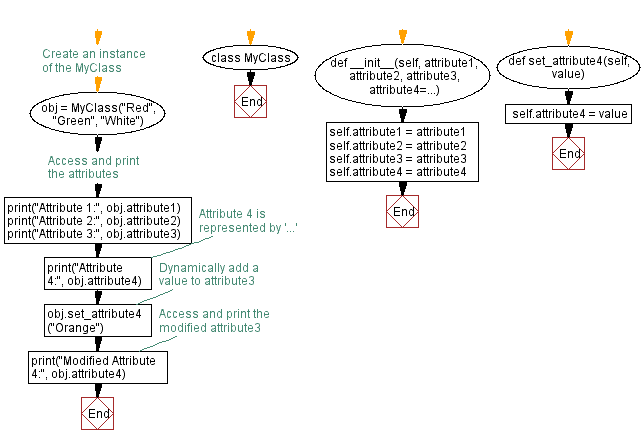Creating Python classes with dynamic attributes
9. Dynamic Attributes with Ellipsis
Write a Python program that creates a custom class with an 'init' method. Use 'ellipsis' to indicate that some attributes may be added dynamically.
Sample Solution:
Code:
class MyClass:
def __init__(self, attribute1, attribute2, attribute3, attribute4=...):
self.attribute1 = attribute1
self.attribute2 = attribute2
self.attribute3 = attribute3
self.attribute4 = attribute4
def set_attribute4(self, value):
self.attribute4 = value
# Create an instance of the MyClass
obj = MyClass("Red", "Green", "White")
# Access and print the attributes
print("Attribute 1:", obj.attribute1)
print("Attribute 2:", obj.attribute2)
print("Attribute 3:", obj.attribute3)
print("Attribute 4:", obj.attribute4) # Attribute 4 is represented by '...'
# Dynamically add a value to attribute3
obj.set_attribute4("Orange")
# Access and print the modified attribute3
print("Modified Attribute 4:", obj.attribute4)
Output:
Attribute 1: Red Attribute 2: Green Attribute 3: White Attribute 4: Ellipsis Modified Attribute 4: Orange
In the exercise above, we define the "MyClass" class with an 'init' method that takes three required attributes ('attribute1', 'attribute2' and 'attribute3') and one optional attribute ('attribute4') represented by 'ellipsis (...)'. This indicates that 'attribute4' may or may not be provided during object creation.
We create an instance of the "MyClass" class and access its attributes. Initially, 'attribute4' is represented by '...' . Later, we dynamically set a value for 'attribute4' using the "set_attribute4()" method.
Flowchart:

For more Practice: Solve these Related Problems:
- Write a Python class with an __init__ method that initializes some attributes with Ellipsis, then dynamically adds more attributes after instantiation and prints the complete object.
- Write a Python program to define a custom class where certain attributes default to Ellipsis, and include a method to update these attributes and verify the changes.
- Write a Python script to create an instance of a class with Ellipsis placeholders for optional attributes, then conditionally set these attributes and display the final state.
- Write a Python function that creates a class instance with Ellipsis as a default value for a property, and then checks if that property is still Ellipsis before performing operations on it.
Go to:
Previous: Extending sequences with ellipsis in Python.
Next: Python Multheading and Concurrency Exercises Home.
Python Code Editor :
What is the difficulty level of this exercise?
Test your Programming skills with w3resource's quiz.
